Common nicknames Presa UKC Guardian Dog | AKC FSS Life span 9 – 11 years | |
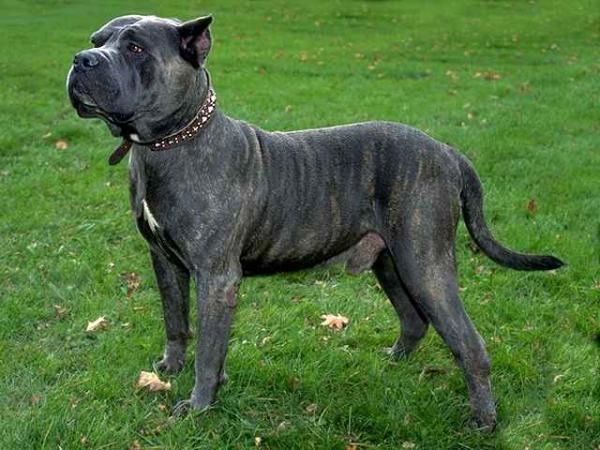 | ||
Other names Canary MastiffCanary Catch DogCanarian MolosserPresa CanarioDogo Canario FCI Group 2, Section 2.1 Molossian: Mastiff type #346 Notes The breed is recognized, by the FCI, on a definitive basis and eligible for the CACIB from 6 July 2011. Temperament Strong Willed, Gentle, Calm, Suspicious, Dominant Height Female: 56–61 cm, Male: 60–65 cm Weight Female: 38–50 kg, Male: 50–59 kg Colors Black, Red Fawn, Fawn, Brindle, Red Brindle, Silver Fawn Similar Dogo Argentino, Cane Corso, Tosa, Bullmastiff, Fila Brasileiro | ||
The Perro de Presa Canario, A.K.A. the Canary Mastiff, is a large Molosser-type dog breed originally bred for working livestock. The name of the breed is Spanish, means "Canarian catch dog", and is often shortened to "Presa Canario" or simply "Presa". The breed is sometimes also called Dogo Canario, meaning "Canarian Molosser". It is the animal symbol of the island of Gran Canaria.
Contents
- Appearance
- History
- Coat and color
- Temperament
- Health
- Lifespan
- Basis for the name and standard
- Attacks against people
- Legal restrictions on ownership
- References
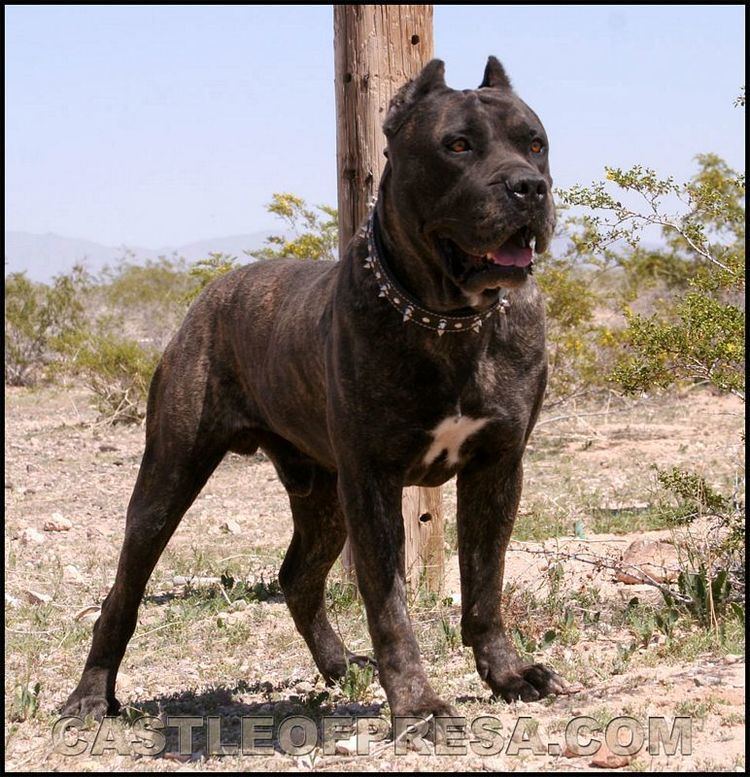
Appearance

First introduced to the world outside of Spain's Canary Islands by the American anthropologist Dr. Carl Semencic in an article for Dog World Magazine and in his books on the subject of rare breeds of dogs, the Presa Canario or "Canary Dog" is a large-size dog with a thick and muscular body. The head is broad, massive, square, and powerful brachycephalic shape. Proper head and good expression are part of the breed standard, and are manifest in the best breed specimens. The ears are normally cropped, both to create a more formidable expression and to prevent damage while working with cattle. If cropped, the ears stand erect. In countries where ear-cropping is banned, the ears are close fitting to the head; they hang down and should be pendant or "rose" shaped. The upper lip is pendulous, although not excessively. Seen from the front, the upper and lower lips come together to form an inverted V. The flews are slightly divergent. The inside of the lips is a dark colour.
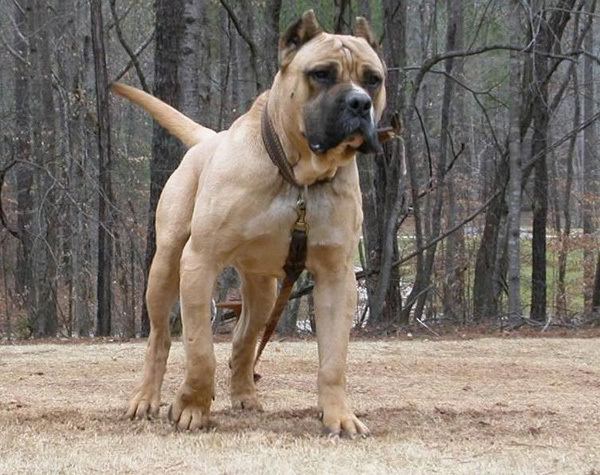
Males have a standard desirable height range of 23 to 26 inches (58 to 66 cm) at the withers, with a minimum weight at maturity of 100 pounds (45 kg) and a maximum weight of 65 kilograms (143 lb). Females have a standard desirable height between 22 to 25 inches (56 to 64 cm) at the withers, with a minimum weight at maturity of 85 pounds (39 kg) and a maximum weight of 120 pounds (55 kg).
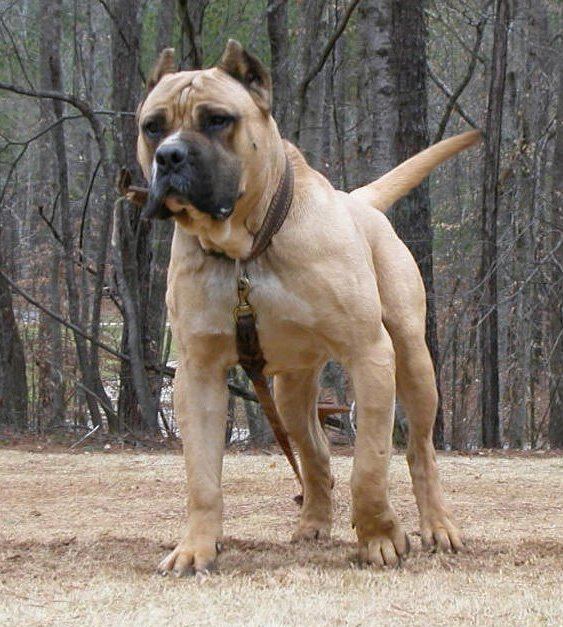
The breed is also characterized by a sloping topline (with the rear being slightly higher than the shoulders). Another characteristic of the breed is the shape of the paws (cat foot) and the catlike movement of the animal. The body is mesomorphic, that is, slightly longer than the dog is tall, contributing to the feline movement.
History
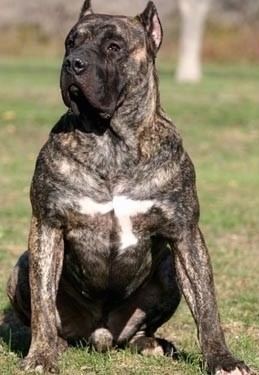
The historian Agustín Millares Torres, in his "General History of the Canary Islands", said the derivation of large dogs that in these islands were [incomplete]. According to his research, these dogs took part in the myths, funeral customs and even gastronomy of the natives (Guanches) of the islands. Demons appeared to these people as big fleecy dogs, known as "Tibicenas" in Gran Canaria and "Irnene" on the island of La Palma. In the funerary cults, the dogs appear mummified beside their owners guides to the afterlife. The dogs were also consumed in small amounts, as has been proven in archaeological discoveries.
In the aftermath of conquest, the presence of these dogs of molosser morphology on the islands is well documented, especially in the cedularios of the councils of Fuerteventura and Tenerife. The first quote after conquest dates from 1501, which allowed the puerqueros (pig farmers) have "one of the larges." In many periods, these dogs were used to kill the wild dogs that attacked cattle. Success was credited by the presentation of the skins of the heads. In others periods, many of these dogs were ordered to be killed for the damage they did to cattle. At one point, residents were given the opportunity to kill loose and wild dogs without punishment. In other occasions the dogs were ordered to be bound. And still other times, due to the damage caused by these dogs, their possession was banned for anyone who was not a farmer or a hunter. All this occurred between the 16th and 18th centuries.
In addition to the traditional role of cattledog, the Perros de Presa have been used for dog fighting. Until the 1950s it remained common practice in all the islands. There exists ample testimony from former fans. The owners agree if witnessed the fight in silence or could incite the animals. No spectator could touch or bother the dogs in combat. The most widespread method was to place the animals within a circle marked on the ground, face to face. The fight began when the collars were removed. These were not organized public events. Instead, they emerged sporadically at the challenge of the owners. However, practically the whole neighborhood participated in the show once it became aware of a fight. The fights were banned in the mid-1940s, but lasted for another decade. From this moment, due to tightening by the Francoist authority for the eradication of dogfighting, the Presa Canario is relegated to counted breeders that fortunately kept the breed preventing its total disappearance.
Coat and color
The coat is short with no undercoating and slightly coarse to the touch. The coat comes in all shades of fawn and brindle. The acceptance of the black coat is a point of contention among fanciers, as it is allowed by the AKC-FSS, UKC and UPPCC standards, but not by the FCI or FCI standards. White is allowed up to 20 percent and is most commonly found on the chest and feet, and occasionally on a blaze on the muzzle. The breed standard requires black pigmentation and dogs should have a black mask that does not extend above the eyes. The breed is known for its minimal shedding.
Temperament
Presas require early socialization and obedience training. In some situations, the Presa can be aggressive toward other dogs and suspicious of strangers.
Health
As a large breed, the Presa Canario can be susceptible to hip dysplasia. Other reported health problems include dilated cardiomyopathy- heart problems and mast-cell tumours - cancer patellar luxation and patellar evulsions, skin cysts, epilepsy, osteochondrodysplasias, demodectic mange and cryptorchidism and Canine leishmaniasis. The latter condition is described empirically as highly likely to affect dogs in areas of Spain and academically described as having increased over 22 years prior to 2006, with risk being highest for dogs that were older, large, lived outside, and lived at the meso-Mediterranean level.
Lifespan
The average lifespan for the Presa Canario is between 8 and 12 years.
Basis for the name and standard
The Presa Canario has a legislative basis in Spain in the form of recognition by a Real Decreto (Royal Decree) of the Ministro de Agricultura, Pesca y Alimentación (Minister of Agriculture Fishing and Nutrition), which was published in the Official Gazette of the Spanish Government ([BOE – Boletin Oficial del Estado]). The original [Real Decreto 558/2001] can be read on the site of the Spanish Government Gazette. In the decree, the breed is referred to as "Presa Canario". A breed standard is attached in the Royal Decree and it includes having a black coat and specifies a maximum weight.
Any other name or standard is not recognized by Spanish law.
In Spain there are two main organizations which are legally recognized by the Minister of Agriculture, Fishing and Nutrition (according to the requirements set by the [Real Decreto 558/2001]): the [RSCE] and the [FCE]. The term "legally recognized" means that these organizations have the power to inscribe the litters into the official Book of Origins of Spain (LOE – Libro de Orígenes Español).
The FCE recognizes the breed according to Spanish law, and uses the Presa Canario name and standard, as set by the [Real Decreto 558/2001].
[An official document] of the Spanish Government has been issued and sent to the RSCE to warn it and to invite it to modify its regulations.
Another recent legal source that identifies the breed is the [Real Decreto 1557/2005]. This decree also states the breed name as "Presa Canario" and gives the legislative power of official association recognition to the local governments.
Attacks against people
Legal restrictions on ownership
Importation and sale of the breed is prohibited in Australia and New Zealand.
